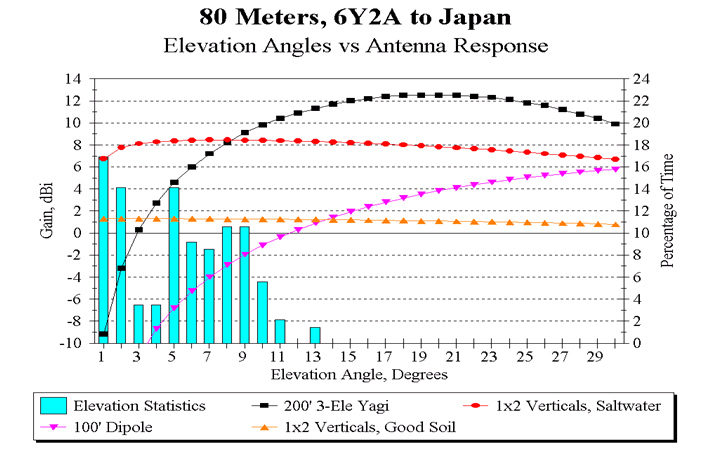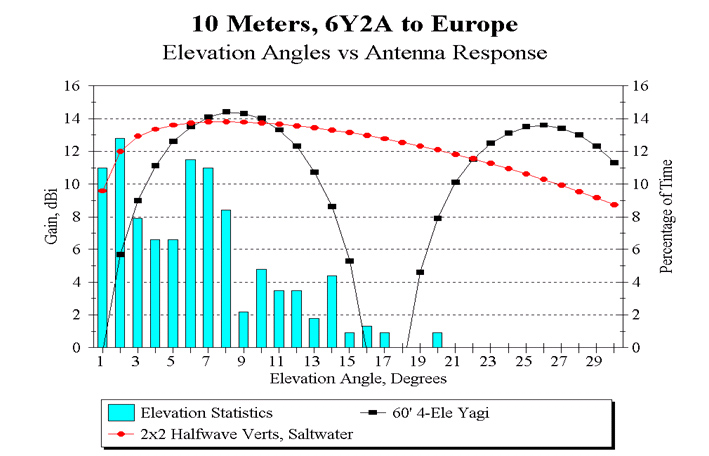Why Vertical Antennas?
The selection of using vertical antennas was not a natural choice. The “conventional wisdom” for contest-expeditions and Dxpeditions was to use Yagi antennas when ever possible, regardless of the height. “Conventional wisdom” would tell you that a 3 ele Yagi at 25′ to 30′ high on 10m, 15m, or 20m would be the correct (if not only) choice.
When first researching our antenna selection, most of the major contesters in the USA said that the Caribbean stations ALWAYS came in at a high angle. Again, more “conventional wisdom” indicating that a low Yagi would be the best choice from Jamaica.
When we were running our propagation programs, the team noticed that the take off angle to the USA was actually a 1-hop LOW angle. Not the high angle that most people indicated. Which was right: conventional wisdom or the computer models?
In our first trip to Jamaica during the ARRL DX CW contest, the group used a blend of antennas:
- Verticals for 40m -160m
- Both a horizontal Yagi and vertical array for 20m
- Yagis for 10m and 15m.
The use of Yagis on the high bands seemed appropriate, as we would elevate them between 0.5 and 1.0 wavelength high. The computer models indicated that the Yagi should perform OK.
While in Jamaica before the contest, the team ran extensive tests with the 20m 2 ele Yagi (45′ high) and the 2 ele parasitic vertical array. The results were astonishing: of the hundreds of tests, there were only a handful of times the horizontal Yagi was better than the vertical array (and only by a small margin).
Most of the time the vertical array was 2 S-units stronger than the horizontal Yagi! In fact, there were many occasions when a signal was an honest S-9 on the verticals (on the FT1000-MP) and S-0 and almost unreadable on the horizontal Yagi. This extreme difference can only be attributed to a signal arriving at a VERY low angle, where the Yagi had little gain.
These results, amidst many additional months of research, convinced the team that verticals by the ocean were the only logical choice for competitive contest-expeditions.
The following graphs were created by N6BV of the ARRL:
The first chart (below) shows an analysis of the take off angles from 6Y2A to Japan on 80m compared to various antenna choices.
First, let’s look at the vertical bars (light blue). This is a statistical grouping of all take off angles between 6Y2A and Japan over all times of the sunspot cycle, over all months of the year, and over all conditions. The data is displayed in the percentage of times a signal will arrive at a given angle: right X-axis is the % of time, and the Y-axis is the take off angle.
Thus by looking at the first bar on the left, we can see that on average, signals will be arriving at 1 degree take off angle nearly 17% of the time. In fact, you can see that ALL signals will arrive at or below 13 degrees on all occasions. Those are very low angles!!
Overlaid on the take off angles are the elevation-plane analysis of standard 80m antennas. Lets look at the 80m dipole at 100′ (pink with inverted triangles). By most standards, this is a very good antenna. But you can clearly see there is little gain at the low angles.
Next, look at the 1 x 2 verticals over good soil (2 ele parasitic vertical array). This antenna provides you with a large improvement over the dipole.
Now lets jump to the “ultimate” 80m antenna: a 3 element full size Yagi at 200′!! There aren’t many of those around, and who ever uses them will rule the band! (based on conventional wisdom). The 3 ele Yagi really does a great job over most arriving signals.
But let’s finally look at the 1 x 2 verticals over salt water (orange with circles). We can see that the verticals have a large advantage over the 80m Yagi at the very low angles. In this example, the verticals have a 16 dB improvement (3 S-units!) advantage over the Yagi. On the higher angles, the vertical still performs well. Overall, we believe the 2 ele vertical array over salt water is a better all around antenna than a full size 3 ele 80m Yagi at 200′!
The next graph examines the take off angles on 10m to Europe. The reference antenna is a 4 element Yagi at 60′, an excellent contesting antenna. You can see that the 10m horizontal Yagi still does not cover the very low angles, and there is a null where there are still many signals arriving.
The comparison array is the 2 x 2 vertical array. The 2 x 2 verticals match the peak gain of the Yagi, but also offer excellent coverage over all arriving angles. Did we say that verticals by the beach rule!?
The team has done extensive modelling to all areas of the world on all bands, the results are typical of the examples above: Vertical arrays over salt water are very competitive antennas.
